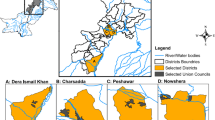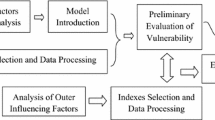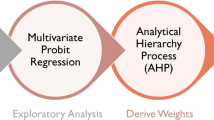Abstract
Population vulnerability of geological disasters is an important way in research on the relationship between human society and its geo-environment. This study examines the provincial administrative units of China as a research object. Twelve indicators are selected on the basis of three aspects, namely population exposure, population capacities, and environmental conditions surrounding people, to construct an index system for the assessment of population vulnerability to geological disasters (including landslide, debris flow, collapse, and land collapse) in China. Criteria importance through Inter-criteria Correlation (CRITIC) and Gray Relational Analysis (GRA) methods is employed to evaluate the population vulnerability of geological disasters in this country. The zoning map of China’s population vulnerability to geological disasters and the ranking of evaluation results are obtained. The results show that the population vulnerability of geological disasters considerably differs in China, which is bounded by the Yellow River. The north of the Yellow River is basically a low population vulnerability zone, whereas the south of this river covers zones with moderate, high, and very high vulnerability. This study can be used as a basis for the reconstruction of the regional population’s ability to resist geological disasters and undergo disaster recovery.





Similar content being viewed by others
References
Azar D, Rain D (2007) Identifying population vulnerable to hydrological hazards in San Juan, Puerto. GeoJournal 69:23–43
Blaikie P, Cannon T, Davis I, Wisner B (1994) At risk: natural hazards, people’s vulnerability and disasters. Routledge, London
Cicone RC, Parris TM, Way DS, Chiesa C (2003) Geospatial Modeling to Identify Populations Vulnerable to Natural Hazards. In: Proceeding of the 30th International Symposium on Remote Sensing of the Environment, Honolulu Hawaii
Cutter SL, Boruff BJ, Shirley WL (2003) Social vulnerability to environmental hazards. Soc Sci Q 84:242–261
Dao H, Peduzzi P (2004) Global evaluation of human risk and vulnerability to natural hazards. Enviro-info 2004, Sh@ring, Editions du Tricorne, Genève, ISBN 282930275–3 (1): 435–446
Deng JL (1987) The primary methods of grey system theory. Huazhong University of Science & Technology Press, Wuhan
Diakoulaki D, Mavrotas G, Papayannakis L (1995) Determining objective weights in multiple criteria problems: the CRITIC method. Comput Oper Res 22:763–770
Gu CJ, Zhang YL, Ma JZ, Ning N (2014) Comprehensive vulnerability evaluation model of debris flow and landslide in mesoscale. China Popul Resour Environ 24:489–494
Guo Y (2013) Natural hazards and social vulnerability. China Social Sciences Press, Beijing
Khan FA, Salman A (2012) A simple human vulnerability index to climate change hazards for Pakistan. International Journal of Disaster Risk Science 3:163–176
Liang LH, Liu ZH (1994) Historical revolution of relation between men and disasters. Journal of Catastrophology 9:89–93
Liu MZ (2016) Vulnerability assessment of storm flood disasters based on fuzzy comprehensive evaluation method-a case of Zhengzhou City. Master’s thesis, Zhengzhou University, Zhengzhou
López-Carr D, Pricope NG, Aukema JE, Jankowska MM, Funk C, Husak G, Michaelsen J (2014) A spatial analysis of population dynamics and climate change in Africa: potential vulnerability hot spots emerge where precipitation declines and demographic pressures coincide. Popul Environ 35:323–339
Méndez-Lázaro P, Peña-Orellana M, Padilla-Elías N, Rivera-Gutiérrez R (2014) The impact of natural hazards on population vulnerability and public health systems in tropical areas. Journal of Geology & Geosciences 3:e114. https://doi.org/10.4172/2329-6755.1000e114
Ministry of Land and Resources of the People's Republic of China (2013) Communiqué on land and resources of China 2012. http://www.mlr.gov.cn
Mondlane A, Popov O, Hansson K (2013) Vulnerability, human behaviour, hazards and expected utility in the context of risk management “the case of Limpopo River basin in Mozambique”. International Journal of Computer Science and Network 2:1–11
National Bureau of Statistics of China (2013) China statistical yearbook 2013. China Statistics Press, Beijing
National Bureau of Statistics of China, Ministry of Environmental Protection of China (2013) China statistical yearbook on environment 2013. China Statistics Press, Beijing
Provincial bureau of statistics (2013) Statistical communiqué of each province on the 2012 economic and social development. http://www.ha.stats.gov.cn
Sodhi MMS (2016) Natural disasters, the economy and population vulnerability as a vicious cycle with exogenous hazards. J Oper Manag 45:101–113
UNDP China, Development Research Center of the State Council of China (2016) China national human development report 2016: social innovation for inclusive human development. China Translation & Publishing House, Beijing
Westgate KN, O’Keefe PO (1976) The human and social implications of earthquake risk for developing countries: Towards an integrated mitigation strategy. Intergovernmental conference on the assessment and mitigation of earthquake risk, 10–19 February 1976, Paris, France
Wood NJ, Peters J (2015) Variations in population vulnerability to tectonic and landslide-related tsunami hazards in Alaska. Nat Hazards 75:1811–1831
Xue KX, Hu YX, Zou YL, Tiwari B, Wei YQ, Gu LS (2016) Temporal–spatial distribution discipline of geological disaster in China in recent ten years. The Chinese Journal of Geological Hazard and Control 27:90–97
Zhang JJ (2013) Spatial–temporal pattern of the hazard-bearing body vulnerability to geo-hazards in Wudu District, China. Master’s thesis, Lanzhou University, Lanzhou
Zhao ZJ (2012) The spatial pattern of the social vulnerability to natural disaster in China. Master’s thesis, Chongqing Normal University, Chongqing
Zheng D (2002) Prospects of studies on man-land relationship in the 21st century. Geogr Res 21:9–13
Zheng HS (2009) Reversion of new introduction to sociology. China Renmin University Press, Beijing
Author information
Authors and Affiliations
Corresponding author
Rights and permissions
About this article
Cite this article
Miao, C., Teng, J., Wang, J. et al. Population vulnerability assessment of geological disasters in China using CRITIC–GRA methods. Arab J Geosci 11, 268 (2018). https://doi.org/10.1007/s12517-018-3598-z
Received:
Accepted:
Published:
DOI: https://doi.org/10.1007/s12517-018-3598-z




